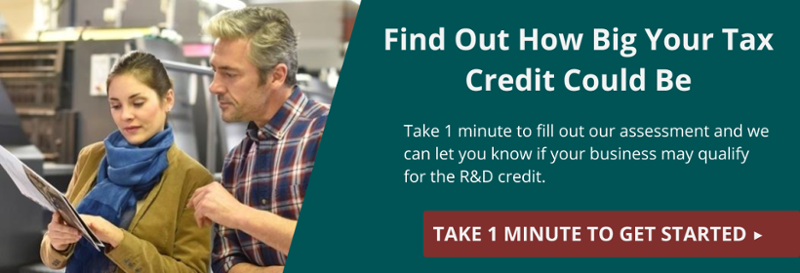
If you’re considering reducing your tax liability by claiming the Research and Development (R&D) Tax Credit for your business, you may have some questions. What does a professional study involve? How much investment is required? How long does it take? Is it even worth the effort?
In a competitive marketplace where manufacturers are constantly searching for ways to grow faster and be more profitable, claiming R&D Tax Credits can inspire companies to reinvest their tax savings back into their businesses.
It starts with conducting an R&D Tax Credit study, with the help of a qualified partner, which can uncover possibilities even the best CPAs wouldn’t see. This article provides an overview of what manufacturers can expect from an R&D Tax Credit study and answers many common questions often asked about the process.
Why Conduct a Study? Why Not?!
Every business wants to compete better, grow faster, and increase profits. Yet, receiving tax credits from everyday R&D activities have additional benefits, too, such as reducing risk when experimenting with new technology. For instance, trying a new tool that could expand product offerings — and being rewarded when that new venture works — is less risky with the financial boost provided by the R&D Tax Credit.
Before a study, however, your partnering firm should conduct a feasibility assessment to get to know your business, departments, supplies, and procedures. At this point, your partner should be using terminology and discussing concepts unique to your industry; familiarity with how you work is critical to uncovering R&D Tax Credits, and real-life industry knowledge is a big advantage.
Most reputable R&D Tax Credit firms then provide a no-cost analysis of the findings. You’ll be able to review your partner’s recommendation on conducting a study or not. Plus, you’ll get to see the estimated savings and overall ROI of claiming federal and state tax credits. It’s a completely no-risk situation.
Note: Some firms base their fees on a percentage of tax credits received, while others charge a fee based on the estimated effort. Work effort would include, but not be limited to, the company size, number and complexity of projects, number of people involved in R&D activities, etc. It’s important that you fully understand your partner’s fee structure prior to conducting a study as well as receive an estimate of your effort.
Committing to a Study
Once all information from the assessment is shared and evaluated, a decision is needed on whether to conduct a study or not. Up to this point, there’s been no cost and no risk to the manufacturer. Now, with facts in hand, an estimated return in mind, and fully comfortable that this partner truly understands their industry, the manufacturer can sign the engagement letter and begin a study.
In addition to feeling at ease with a firm’s knowledge and abilities, it’s critical to understand how (or if) a partner can justify their claims. Although IRS audits are rare, it’s comforting for a manufacturer to know that claims will be defended by the partner.
Depending on the manufacturer’s specific industry, various members of the team will be included in the study. That may sound like a big commitment from numerous, already busy individuals, but the time investment to complete a typical study for a new customer is 20-35 total hours.
Doesn’t a CPA Handle This?
CPAs know a lot and can be very helpful; that’s why you hire them. Yet, few CPAs have manufacturing knowledge and background in different industries. It’s just not their job.
The right partner should greatly exceed the R&D opportunities that a CPA can discover. Here are some real-life examples:
- A manufacturer that claimed $5,000/year safely expanded that to over $320,000/year after completing a full study
- Another company realized a return of $6,193 for every hour invested
- A third realized a 2,120% ROI
Having in-depth manufacturing knowledge made all the difference in these cases.
Of course, all IRS rules need to be followed. If any claim is even close to the edge of allowability, it’s discussed between the customer and partner.
Common Questions About an R&D Study
Here are some common questions we receive at Black Line Group (BLG) regarding R&D Tax Credit studies. It’s important to note that the answers are specific to our experiences at BLG, not the typical professional services firm a manufacturer may hire.
• “Am I more at risk of being audited when claiming the R&D Tax Credit?”
Yes, there is some risk, however, only 1.3% of Black Line Group customers get audited by the Internal Revenue Service.
“Black Line Group demonstrates the integrity and fortitude to do an exceptional job to legally maximize credits for clients while not being antagonistic with the IRS. I think this is in the best interest of the client to minimize cost, optimize resources, and resolve conflict with the IRS.” — Michael Gregory, NSA, MBA, ASA, CVA, MN Supreme Court Qualified Mediator
• “How aggressive does a firm get when claiming R&D Tax Credits?”
At BLG, we claim as much as what’s allowed by law, never putting a customer at risk. In the slim chance you are audited, we want to be 100% comfortable defending every dime that has been claimed.
• “Will my R&D Tax Credit firm defend my claim to these credits?”
The right ones will! BLG will not claim a dime on a company’s behalf that cannot be substantiated. Period.
• “Can’t my CPA handle this claim? Why do I need a company like BLG?”
As previously mentioned, most CPAs don’t have manufacturing knowledge, nor are R&D Tax Credits technical knowledge (the tax credit isn’t covered on the CPA test).
• “What areas of my company will be targeted to participate?”
It’s important to search beyond a laboratory environment to find R&D Tax Credits. BLG connects with various team members during a study: sales, quoting, engineering, design, quality approval, and more.
• “Is ownership expected to be involved in the study?”
For manufacturers with sales of $10-$50 million, having ownership (president/CEO) involved from the beginning helps confirm the “big picture” benefits of the study and unites other participating employees. For larger companies ($50+ million), involving a VP of Tax and/or Tax Manager is imperative.
• “How many hours will my people be required to invest in order to complete a study?”
The total time investment to complete a study is about 20-35 hours, which includes meeting time. The exact amount depends on your company’s structure, and the amount of R&D activity your company is currently doing.
• “Will less hours be required in subsequent years of claiming?”
Yes. As companies become familiar with the process, they can expect to see a dramatic reduction in hours required to submit a claim in upcoming years: up to 30%.
• “How long before I realize the cash benefits from a study?”
It typically takes 3 months to receive the credit after forms are filed. However, you may realize a cash benefit sooner if the R&D Tax Credit reduces estimated tax currently due.
• “How do you measure the success of an R&D study?”
No doubt, the ROI must be significant in order for a study to be judged successful. But it goes deeper than that for BLG. “Is our client happy?” is the recurring question asked. During a project conclusion call, a survey is taken to measure satisfaction. BLG is currently running a 9.7 NPS (net promoter score) on a 1-10 scale. This is a world-class customer satisfaction rating.
Another standard to achieve is the ability to exceed a customer’s expectations as well as the estimated savings shared in the initial assessment. BLG’s mantra of “under promise, over deliver” has proven to be wise words to live by.
• “What does a study cost?”
BLG charges a fixed fee based on estimated time required to complete the study (not taking a percentage). We’re happy to provide you with enough information to make the best decision for your business. Learn more on our pricing page.





